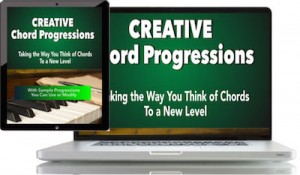Good songwriting means creating a strong partnership between all the various elements of your song. You know you’ve got a good song when your lyrics, melodies, chords, rhythms, instrumentation/production and formal design all support each other.
It’s not easy to troubleshoot a song that has problems. You can tell just by listening that something’s not right, but that doesn’t mean that the cause of the problem is that obvious. Sometimes, a problem can come from an issue with one isolated element. For example, it may not occur to you that the melody is lacking a defining high point. Or that the instrumentation you’ve chosen just doesn’t really demand any sort of attention.
 Chapter 5 of “The Essential Secrets of Songwriting”, 3rd edition, describes how melodies and lyrics work together. It’s practically impossible to consider writing a great song if you don’t consider how these two vital song components work together. Get the 10-eBook Bundle — a complete songwriting package that will get you writing better songs!
Chapter 5 of “The Essential Secrets of Songwriting”, 3rd edition, describes how melodies and lyrics work together. It’s practically impossible to consider writing a great song if you don’t consider how these two vital song components work together. Get the 10-eBook Bundle — a complete songwriting package that will get you writing better songs!
But often, the problem is how one element (lyrics, let’s say) works — or doesn’t work — with the melody. But how do you determine that? What kind of a relationship should a melody and lyric have? How do you know that the melody is properly supporting the lyric?
Here’s a short list of tips to think about as you wonder if your lyrics and melodies are paying nice with each other:
- Let your melody move up when lyrics become emotional. The human voice, when singing in a higher range, displays stronger emotions. When your lyrics are mainly about how you feel about something, find ways to move the melody higher. (This happens chiefly in a chorus.)
- Let your melody move down when lyrics become observational or narrative. As the voice moves lower, emotions dissipate, and it’s a great way to keep your song from being emotionally intense all the time. (Consider lower melodies for verses.)
- Let the rhythms of your melodies elongate when lyrics are describing emotions. Make sure that your lyric, at those moments when the song title is being sung for example, feature longer words. Lorde’s hit “Royals” demonstrates this, as you hear that word “royals” being stretched out more than the other surrounding words.
- Let the rhythms of your melodies simplify when lyrics describing emotions. This happens a lot in song choruses. Verses may feature rhythmic complexities, but the chorus generally allows rhythms to become simpler, more locked into a groove or riff. The chorus of “We Are Young” (fun. feat. Janelle Monae) demonstrates this tip.
- Place lyrics in a melody so that the natural pulse of the words is honoured. Think about the natural accents of your words, and think about the natural strong beat – weak beat of your melody, and put the two together.
- Let the natural up and down contour of word pronunciation help to shape a melody. You notice when you say a word like “umbrella” that we naturally pitch the middle syllable higher, while the word “telephone” has the first syllable as sounding higher. Use those natural contour lines to help shape a melody.
- Don’t be afraid to change words. Sometimes you can be tempted to change something about your melody in order to make the words fit better. But consider the power of a great melody, and don’t be afraid to make changes to your lyrics in order to preserve a lovely moment in the melody that you’re creating.
- Consider an upward key change to allow a melody to generate more intensity. Let’s say that your lyric is creating a nice ebb and flow of musical energy, but now the lyric seems to pump things up even higher. How do you ensure that your melody is allowing for this greater since of musical energy? You might consider changing the key upward — perhaps from C major to Db or D major. Just that one bump can help the impact that your lyric has on the listener.
Written by Gary Ewer. Follow Gary on Twitter.

 “The Essential Secrets of Songwriting” eBook Bundle packages explore 11 principles of songwriting, and will take your own music to a new level of excellence. Right now, download a FREE COPY of “Creative Chord Progressions”, when you get the 10-ebook Bundle.
“The Essential Secrets of Songwriting” eBook Bundle packages explore 11 principles of songwriting, and will take your own music to a new level of excellence. Right now, download a FREE COPY of “Creative Chord Progressions”, when you get the 10-ebook Bundle.










